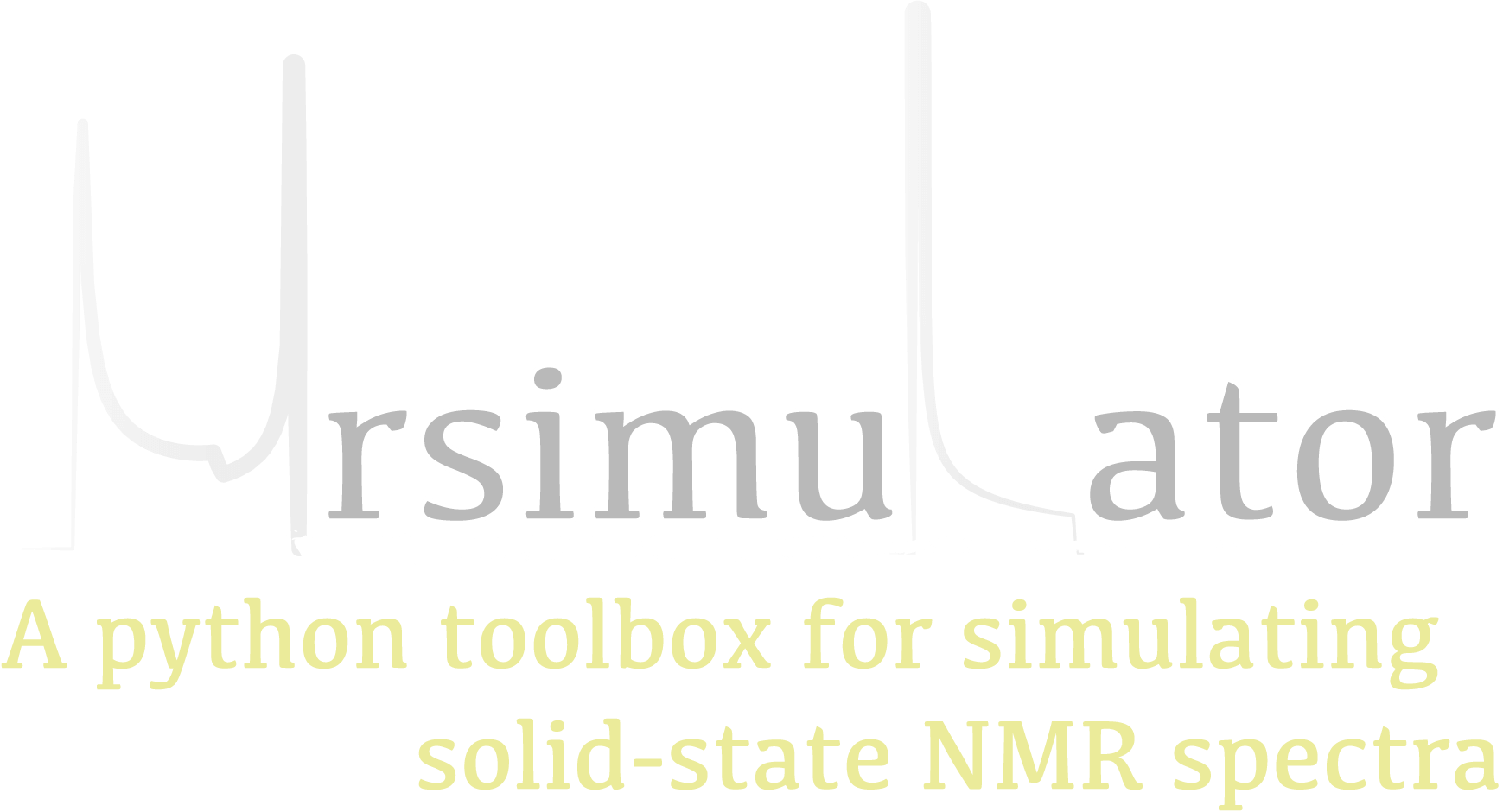Note
Go to the end to download the full example code
¹³C MAS NMR of Glycine (CSA) [960 Hz]¶
The following is a sideband least-squares fitting example of a \(^{13}\text{C}\) MAS NMR spectrum of Glycine spinning at 960 Hz. The following experimental dataset is a part of DMFIT [1] examples. We thank Dr. Dominique Massiot for sharing the dataset.
import csdmpy as cp
import numpy as np
import matplotlib.pyplot as plt
from lmfit import Minimizer
from mrsimulator import Simulator, SpinSystem, Site
from mrsimulator.method.lib import BlochDecaySpectrum
from mrsimulator import signal_processor as sp
from mrsimulator.utils import spectral_fitting as sf
from mrsimulator.utils import get_spectral_dimensions
Import the dataset¶
host = "https://nmr.cemhti.cnrs-orleans.fr/Dmfit/Help/csdm/"
filename = "13C MAS 960Hz - Glycine.csdf"
experiment = cp.load(host + filename)
# For spectral fitting, we only focus on the real part of the complex dataset
experiment = experiment.real
# Convert the coordinates along each dimension from Hz to ppm.
_ = [item.to("ppm", "nmr_frequency_ratio") for item in experiment.dimensions]
# plot of the dataset.
plt.figure(figsize=(8, 4))
ax = plt.subplot(projection="csdm")
ax.plot(experiment, color="black", linewidth=0.5, label="Experiment")
ax.set_xlim(280, -10)
plt.grid()
plt.tight_layout()
plt.show()
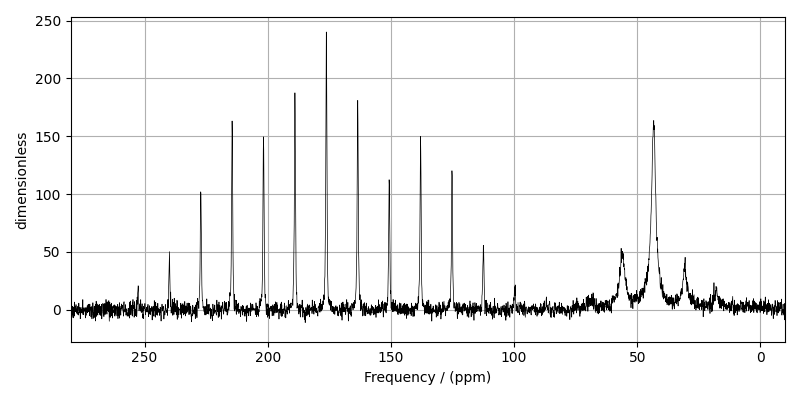
Estimate noise statistics from the dataset
coords = experiment.dimensions[0].coordinates
noise_region = np.where(coords < 10e-6)
noise_data = experiment[noise_region]
plt.figure(figsize=(3.75, 2.5))
ax = plt.subplot(projection="csdm")
ax.plot(noise_data, label="noise")
plt.title("Noise section")
plt.axis("off")
plt.tight_layout()
plt.show()
noise_mean, sigma = experiment[noise_region].mean(), experiment[noise_region].std()
noise_mean, sigma
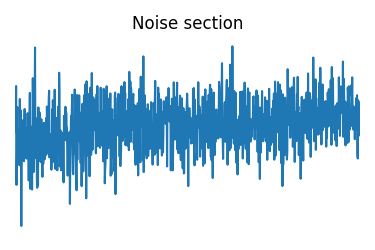
(<Quantity 0.6193483>, <Quantity 3.939941>)
Create a fitting model¶
Spin System
C1 = Site(
isotope="13C",
isotropic_chemical_shift=176.0, # in ppm
shielding_symmetric={"zeta": 70, "eta": 0.6}, # zeta in Hz
)
C2 = Site(
isotope="13C",
isotropic_chemical_shift=43.0, # in ppm
shielding_symmetric={"zeta": 30, "eta": 0.5}, # zeta in Hz
)
spin_systems = [SpinSystem(sites=[C1], name="C1"), SpinSystem(sites=[C2], name="C2")]
Method
# Get the spectral dimension parameters from the experiment.
spectral_dims = get_spectral_dimensions(experiment)
MAS = BlochDecaySpectrum(
channels=["13C"],
magnetic_flux_density=7.05, # in T
rotor_frequency=960, # in Hz
spectral_dimensions=spectral_dims,
experiment=experiment, # experimental dataset
)
Guess Model Spectrum
# Simulation
# ----------
sim = Simulator(spin_systems=spin_systems, methods=[MAS])
sim.config.decompose_spectrum = "spin_system"
sim.run()
# Post Simulation Processing
# --------------------------
processor = sp.SignalProcessor(
operations=[
sp.IFFT(),
sp.apodization.Exponential(FWHM="20 Hz", dv_index=0), # spin system 0
sp.apodization.Exponential(FWHM="200 Hz", dv_index=1), # spin system 1
sp.FFT(),
sp.Scale(factor=1000),
]
)
processed_dataset = processor.apply_operations(dataset=sim.methods[0].simulation).real
# Plot of the guess Spectrum
# --------------------------
plt.figure(figsize=(8, 4))
ax = plt.subplot(projection="csdm")
ax.plot(experiment, color="black", linewidth=0.5, label="Experiment")
ax.plot(processed_dataset, linewidth=2, alpha=0.6)
ax.set_xlim(280, -10)
plt.grid()
plt.legend()
plt.tight_layout()
plt.show()
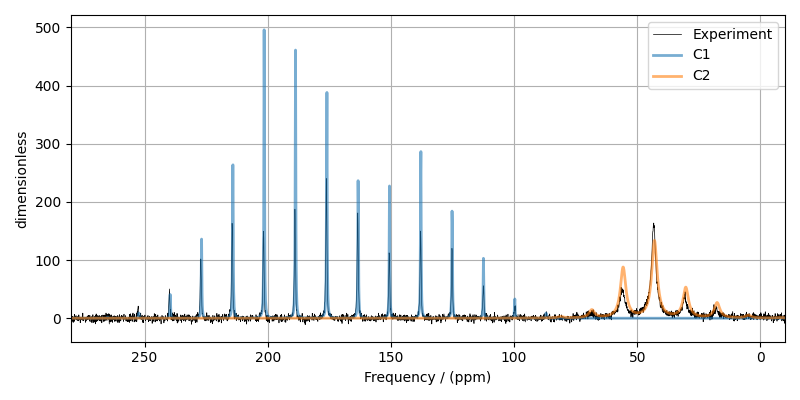
Least-squares minimization with LMFIT¶
Use the make_LMFIT_params() for a quick
setup of the fitting parameters.
params = sf.make_LMFIT_params(sim, processor, include={"rotor_frequency"})
print(params.pretty_print(columns=["value", "min", "max", "vary", "expr"]))
Name Value Min Max Vary Expr
SP_0_operation_1_Exponential_FWHM 20 -inf inf True None
SP_0_operation_2_Exponential_FWHM 200 -inf inf True None
SP_0_operation_4_Scale_factor 1000 -inf inf True None
mth_0_rotor_frequency 960 860 1060 True None
sys_0_abundance 50 0 100 True None
sys_0_site_0_isotropic_chemical_shift 176 -inf inf True None
sys_0_site_0_shielding_symmetric_eta 0.6 0 1 True None
sys_0_site_0_shielding_symmetric_zeta 70 -inf inf True None
sys_1_abundance 50 0 100 False 100-sys_0_abundance
sys_1_site_0_isotropic_chemical_shift 43 -inf inf True None
sys_1_site_0_shielding_symmetric_eta 0.5 0 1 True None
sys_1_site_0_shielding_symmetric_zeta 30 -inf inf True None
None
Solve the minimizer using LMFIT
opt = sim.optimize()
minner = Minimizer(
sf.LMFIT_min_function,
params,
fcn_args=(sim, processor, sigma),
fcn_kws={"opt": opt},
)
result = minner.minimize()
result
The best fit solution¶
best_fit = sf.bestfit(sim, processor)[0].real
residuals = sf.residuals(sim, processor)[0].real
plt.figure(figsize=(8, 4))
ax = plt.subplot(projection="csdm")
ax.plot(experiment, color="black", linewidth=0.5, label="Experiment")
ax.plot(residuals, color="gray", linewidth=0.5, label="Residual")
ax.plot(best_fit, linewidth=2, alpha=0.6)
ax.set_xlim(280, -10)
plt.grid()
plt.legend()
plt.tight_layout()
plt.show()
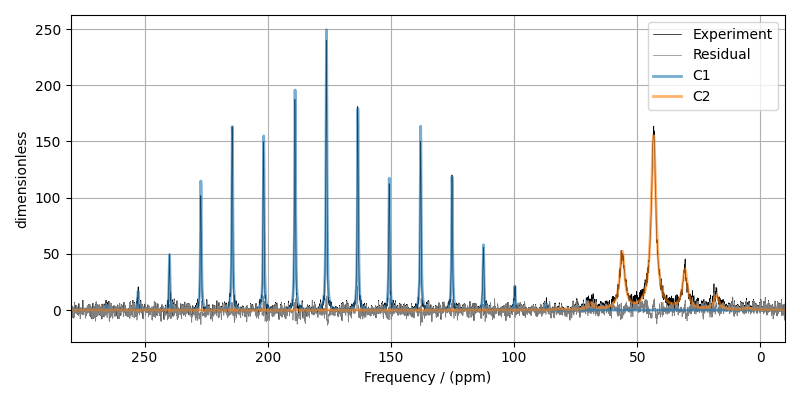
Total running time of the script: (0 minutes 4.354 seconds)
